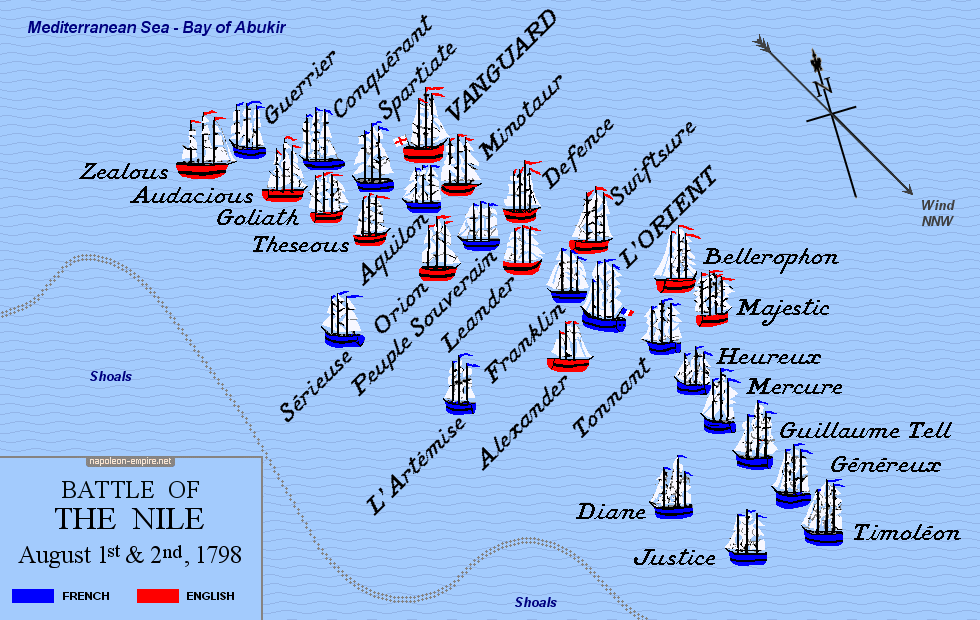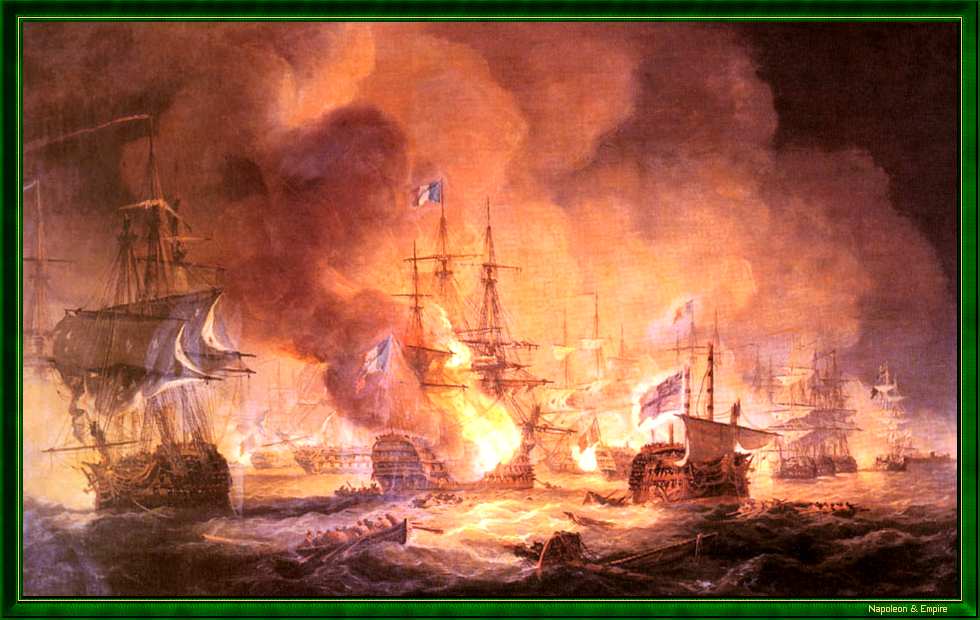Date and place
- August 1st and 2nd, 1798 in Abukir Bay, Egypt.
Involved forces
- French float (17 ships), under Rear-Admiral François Paul de Brueys d'Aigalliers.
- English float (14 ships), under Rear-Admiral Horatio Nelson.
Casualties and losses
- French float : between 2,000 and 5,000 killed or wounded, from 3,000 to 3,900 prisoners.
- English float : 218 killed, 677 injured.
The general situation
After the landing of the French army in front of Alexandria [الإسكندرية] [31.20569, 29.88190], whose port did not offer sufficient draft for the largest ships of the fleet, the latter went to anchor in the harbor of Abukir [أبو قير] [31.32415, 30.07265], 22 kilometers to the northeast.
Its leader, Admiral Brueys, perhaps intended to take to the sea, where he would find himself less exposed to attack. However, he did not dare to do so before being certain that the army was safe in Cairo [القاهرة].
This departure at sea seems to have been desired by General Napoleon Bonaparte himself. Unfortunately for the French, the formal order to weigh anchor that he sent to Brueys at the end of July never reached its recipient, the messenger having been killed en route by Bedouins.
The French fleet was deployed in line, three or four kilometers (1.5 to 2 nautical miles) from the coast and parallel to it.
The fleets present
The Battle of the Nile, also known as the "Battle of Abukir Bay", involved:
On the one hand, the French fleet of the Egyptian campaign, commanded by Rear Admiral François Paul de Brueys d'Aigalliers , made up of 17 ships (13 ships of the line and 4 frigates):
- Le Guerrier
- Le Conquérant
- La Sérieuse
- Le Spartiate
- L'Aquilon
- L'Artémise
- Le Peuple Souverain
- Le Franklin
- L'Orient (flagship)
- Le Tonnant
- La Diane
- L'Heureux
- Le Mercure
- La Justice
- Le Guillaume Tell
- Le Généreux
- Le Timoléon
On the other hand, an English fleet under the orders of Rear Admiral Horatio Nelson, including the following ships (14 ships of the line and a brig):
- HMS Zealous
- HMS Audacious
- HMS Goliath
- HMS Theseous
- HMS Vanguard (flagship)
- HMS Orion
- HMS Minotaur
- HMS Defence
- HMS Leander
- HMS Alexander
- HMS Swiftsure
- HMS Bellerophon
- HMS Majestic
- HMS Culloden
- HMS La Mutine
(the last two did not participate in the battle: the HMS Culloden was stranded on a shoal a few nautical miles to the north and the HMS Mutine came to its aid).
The battle
On August 1, Nelson, after having searched for it for a long time, flushed out the French squadron and attacked it without delay. It was around 6 p.m.
Admiral Brueys, not very confident in the quality of his crews and some of his officers, decided to fight while remaining at anchor, which obviously deprived him of any mobility.
Half of the English ships thus managed to slip between the coast and the French boats. The other half lined up with them on the east side, taking about half of the French fleet in the crossfire.
In the attacked part, the damage was immediately immense. Admiral Brueys was wounded at the start of the action but continued to command until a cannonball cut him almost in two around 7:30 p.m., which left the fleet without command at the height of the combat.
Several other admirals or senior officers were also killed. Admiral Pierre Charles Silvestre de Villeneuve, for his part, without taking part in the action, managed to escape with two ships of the line and two frigates.
In total, 4 French ships were destroyed, including the flagship "L'Orient', which was set on fire and ended up blowing up around 10 p.m.; nine others were taken. The French counted 1,700 dead, 1,000 wounded and 2,000 prisoners; the English 218 dead and 677 wounded, including Nelson himself.
Aftermath
It was a severe defeat for France, whose fleet was almost completely destroyed (the remaining ships, less efficient, suffered the same fate seven years later at Trafalgar). The country will not be able to replace it for several decades, definitively abandoning control of the seas to the English.
It was also a fatal blow to an Egyptian expedition that had barely begun. Bonaparte was now a prisoner on Egyptian soil, without hope of receiving aid and reinforcements, or even of bringing his army back to France, as subsequent events would show.
Map of the battle of the Nile (Battle of Abukir Bay)

Picture - "Battle of the Nile, August 1st 1798 at 10 PM". Painted in 1830 by Thomas Luny.

Admiral Nelson, already famous, received numerous honors for this victory, including the title of Baron of the Nile (which he however considered insufficient and briefly considered refusing).
List of naval battles of the French Revolutionary and Napoleonic Wars.Photos Credits
Photos by Lionel A. Bouchon.Photos by Marie-Albe Grau.
Photos by Floriane Grau.
Photos by Michèle Grau-Ghelardi.
Photos by Didier Grau.
Photos made by people outside the Napoleon & Empire association.